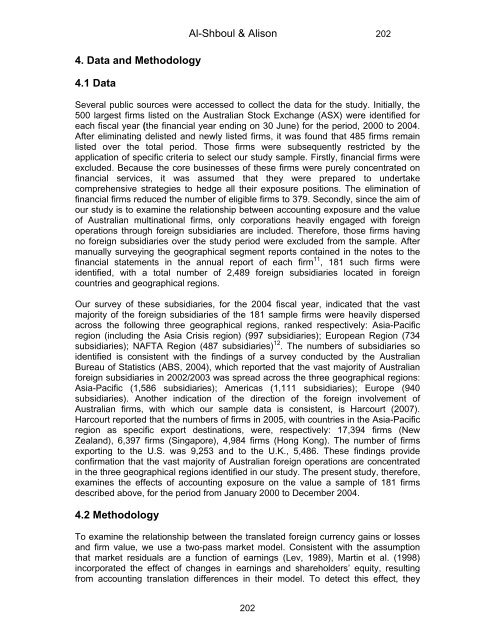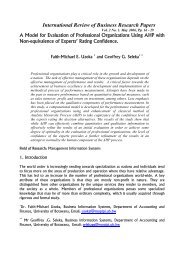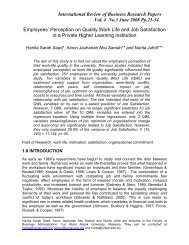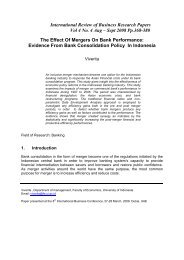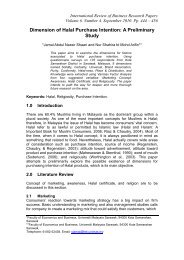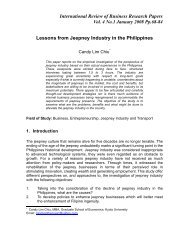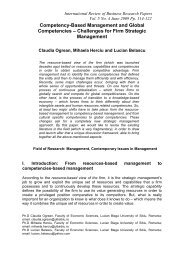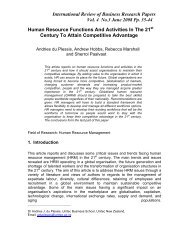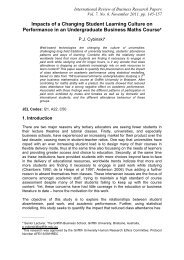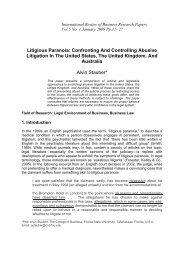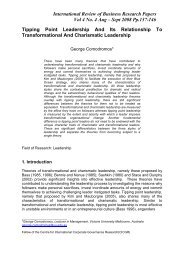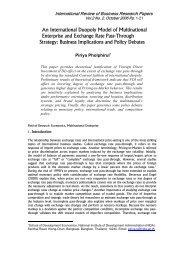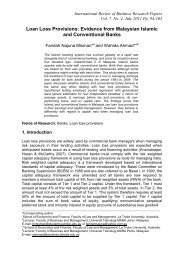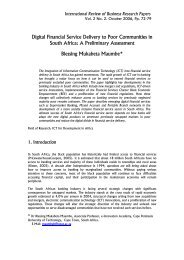Translation Exposure and Firm Value, Evidence From Australian ...
Translation Exposure and Firm Value, Evidence From Australian ...
Translation Exposure and Firm Value, Evidence From Australian ...
You also want an ePaper? Increase the reach of your titles
YUMPU automatically turns print PDFs into web optimized ePapers that Google loves.
4. Data <strong>and</strong> Methodology4.1 DataAl-Shboul & Alison 202Several public sources were accessed to collect the data for the study. Initially, the500 largest firms listed on the <strong>Australian</strong> Stock Exchange (ASX) were identified foreach fiscal year (the financial year ending on 30 June) for the period, 2000 to 2004.After eliminating delisted <strong>and</strong> newly listed firms, it was found that 485 firms remainlisted over the total period. Those firms were subsequently restricted by theapplication of specific criteria to select our study sample. Firstly, financial firms wereexcluded. Because the core businesses of these firms were purely concentrated onfinancial services, it was assumed that they were prepared to undertakecomprehensive strategies to hedge all their exposure positions. The elimination offinancial firms reduced the number of eligible firms to 379. Secondly, since the aim ofour study is to examine the relationship between accounting exposure <strong>and</strong> the valueof <strong>Australian</strong> multinational firms, only corporations heavily engaged with foreignoperations through foreign subsidiaries are included. Therefore, those firms havingno foreign subsidiaries over the study period were excluded from the sample. Aftermanually surveying the geographical segment reports contained in the notes to thefinancial statements in the annual report of each firm 11 , 181 such firms wereidentified, with a total number of 2,489 foreign subsidiaries located in foreigncountries <strong>and</strong> geographical regions.Our survey of these subsidiaries, for the 2004 fiscal year, indicated that the vastmajority of the foreign subsidiaries of the 181 sample firms were heavily dispersedacross the following three geographical regions, ranked respectively: Asia-Pacificregion (including the Asia Crisis region) (997 subsidiaries); European Region (734subsidiaries); NAFTA Region (487 subsidiaries) 12 . The numbers of subsidiaries soidentified is consistent with the findings of a survey conducted by the <strong>Australian</strong>Bureau of Statistics (ABS, 2004), which reported that the vast majority of <strong>Australian</strong>foreign subsidiaries in 2002/2003 was spread across the three geographical regions:Asia-Pacific (1,586 subsidiaries); Americas (1,111 subsidiaries); Europe (940subsidiaries). Another indication of the direction of the foreign involvement of<strong>Australian</strong> firms, with which our sample data is consistent, is Harcourt (2007).Harcourt reported that the numbers of firms in 2005, with countries in the Asia-Pacificregion as specific export destinations, were, respectively: 17,394 firms (NewZeal<strong>and</strong>), 6,397 firms (Singapore), 4,984 firms (Hong Kong). The number of firmsexporting to the U.S. was 9,253 <strong>and</strong> to the U.K., 5,486. These findings provideconfirmation that the vast majority of <strong>Australian</strong> foreign operations are concentratedin the three geographical regions identified in our study. The present study, therefore,examines the effects of accounting exposure on the value a sample of 181 firmsdescribed above, for the period from January 2000 to December 2004.4.2 MethodologyTo examine the relationship between the translated foreign currency gains or losses<strong>and</strong> firm value, we use a two-pass market model. Consistent with the assumptionthat market residuals are a function of earnings (Lev, 1989), Martin et al. (1998)incorporated the effect of changes in earnings <strong>and</strong> shareholders’ equity, resultingfrom accounting translation differences in their model. To detect this effect, they202


